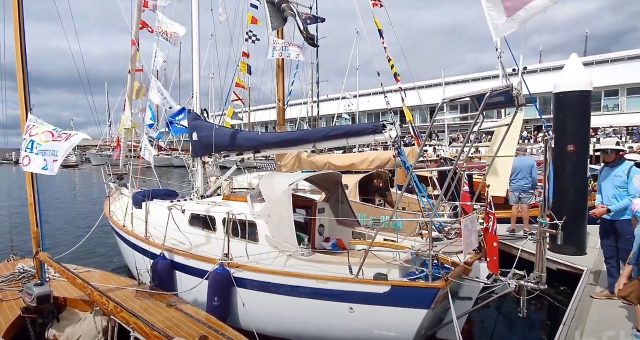
SPRING NEWSLETTER MARCH 2023
Here are Island Vertue and Tui (above), alongside one another in Hobart, ‘lending tone’ to one of the world’s great traditional sailing festivals. We are lucky to have so many keen Vertue owners in that corner of the world, some of whom have very kindly sent full reports of the proceedings.
Meanwhile, we are always trying to improve the Vertue database that is easily ‘searchable’ on this modest website, so I have included another appeal for information on one of the elegant grp Vertues: please contact me if you can help, with this or would like to contribute anything at all to our website.
It is well known that the Laurent Giles Partnership were involved with the design of numerous other cruising and racing yachts after Andrillot was conceived in the mid-1930’s. They were mostly larger boats, and there can be traced a steady design development of this type of yacht over the following years. I like to think of this as a kind of ‘Design Dynasty’, and this Newsletter continues the story. I hope you enjoy this latest episode. There will be another instalment in the next Newsletter this Summer, and one of Jack Laurent Giles’ most famous creations will be the star of the show!
_______________
Perhaps one of the best illustrations of the international appeal of Vertues is the presence of so many in Australia and New Zealand. This is partly because several were built there by ‘self-builders’ from the late 1950’s onwards. (Mike Mckeon has kindly put me right about this, as his Austral Vertue and Bass Vertue were both built before 1960). I can hardly believe that it’s nine years since we first came across some of these boats at the 2014 Australian Wooden Boat Festival in Hobart, and some of those same boats have just re-appeared at this year’s event last month.
Tui of Opua is one of the most celebrated Aussi Vertues, and her owners, Bruce and Thelma Morley, built her themselves over several years. This year they sailed down to Hobart again, from Newcastle NSW, for the Festival and Bruce has kindly sent over an interesting account of their passage south: so here it is!
From Newcastle to Hobart with Tui of Opua
“Here is a report on the Australian Wooden Boat Festival held in Hobart in February this year. I hope you will find it interesting.
Tui of Opua was prepared as well as we were able for the sail south to Hobart, in order to be part of the bi-annual Australian Wooden Boat Festival. The distance from Newcastle to Hobart is about 710 nm and we had a loose plan to arrive in Hobart by the end of January. One date that we needed to keep was the 19th of December as this was Thelma’s next appointment for a procedure at the Hospital in Newcastle NSW.
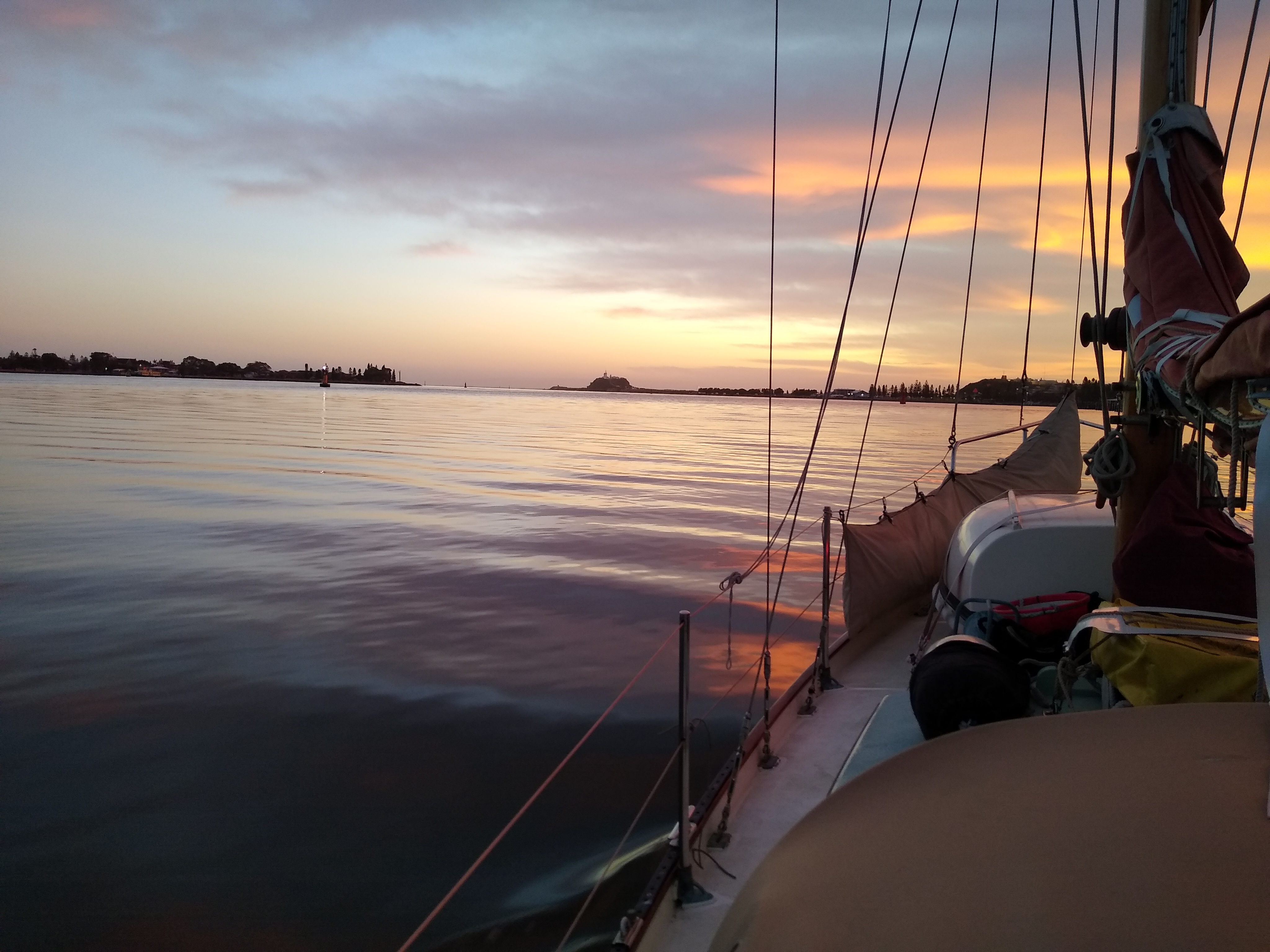
We had a favourable wind forecast on the 7th December 2022, so we slipped our lines and headed out of Newcastle harbour at 0700 hours.
We had light and variable wind which meant some motor sailing. The last 10nm into Pittwater north of Sydney Harbour with wind came up to 20 to 25 knots and gave Tui of Opua and her crew a brisk sail for the last 2 hours. We picked up one of the moorings in the Basin which is just inside the entrance to the Hawksbury River and Pittwater. After a stay of 4 days during which time we were able to catch up with friends. Also, whilst we were there, on a mooring, another vessel collided with the port side and inflicted a small but deep scratch in the topsides. This is the second time we have suffered damage to our topsides whilst on a mooring in Pittwater. I will need to repair the damage with a graving piece next time we have Tui on the slip.
We headed out of Pittwater for the sail down to Port Hacking a distance of about 30nm south of Sydney adjacent to the Royal National Park, which is the second oldest national park in the world. It was here in Port Hacking we found a tiny pin hole leak in the engine injector return line that had been giving the yacht a slight diesel smell and although I had looked previously I had done so when the engine was stopped and this time I looked with the engine running. We were able to clean up the small amount of diesel from the bilge along with soapy fresh water into a couple of containers. We then had the problem of how to dispose of the water/diesel mix, as there are no facilities in Port Hacking where we could dispose waste. Fortunately our friend Dick arrived in his timber fishing boat and took the waste away to a certified waste disposal facility.
After a couple of days in Port Hacking we sailed down to a brand new Marina at Shell Harbour which is just south of Port Kembla. It was here in Shell Harbour we had planned to leave Tui of Opua and catch the train back to Newcastle so Thelma could visit the hospital as planned. All went well at the hospital and the following day we took the train back to Shell Harbour. After a couple of days waiting for suitable weather we sailed on to Batemans Bay with an overnight stay in Ulladulla. We planned to stay in Batemans Bay for Christmas before sailing to Bermagui were we would wait for a weather window to cross the Bass Straight.
Bermagui is a delightful town on the NSW south coast, and as the entrance bar is one of the safest, it is used as a fishing vessel harbour by a large number of vessels catching tuna. The town centre is just a walk away with good provisioning stores open 7 days a week. Here we met with several wooden yachts heading to Hobart and the Festival, along with many other yachts heading to Tasmania who would also be attending the festival. We watched the weather forecasts and decided that we would sail to Eden which is the last port before crossing Bass Straight. We would need to wait in Eden for a couple of days before heading further south to Hobart. Eden has a few good anchoring areas to wait out the weather.
At 0500 hours on the morning of 11th January we raised the anchor and headed out from the anchorage behind the Navy wharf towards Tasmania. We had various options that we would choose depending on the weather. The forecast was for northerly sector winds from 10 knots to 25 knots for the next 3 days which would allow us to be on the Tasmanian east coast before any wind change. We were not alone, as 8 other vessels departed Eden as we did. All had passed Tui of Opua before we were abeam of Gabo Island, Tui being the smallest yacht heading south. The weather was mixed for the crossing with our speed over the ground up to 7 knots, as we rode the south bound current after passing Gabo Island. For the most we were travelling at between 4.5 and 5.5 knots with a number 2 headsail and a single reefed main. We used our Simrad autopilot for the complete crossing holding us on the rhumb line from Gabo Island to Schouten Island on Tasmania’s east coast. The crossing and the sail up to Triabunna harbour, took us 3 days and 4 hours which is an average daily distance of 112 nm.
We arrived in Triabunna and were able to have a marina berth in the small marina in the centre of the town. The town has excellent shower and laundry facilities along with a good shopping centre, and a great fish and chip cafe on the waterfront. Triabunna is the port for the ferry taking visitors to Maria Island National Park which was the site of a penal colony in the early 1800’s.
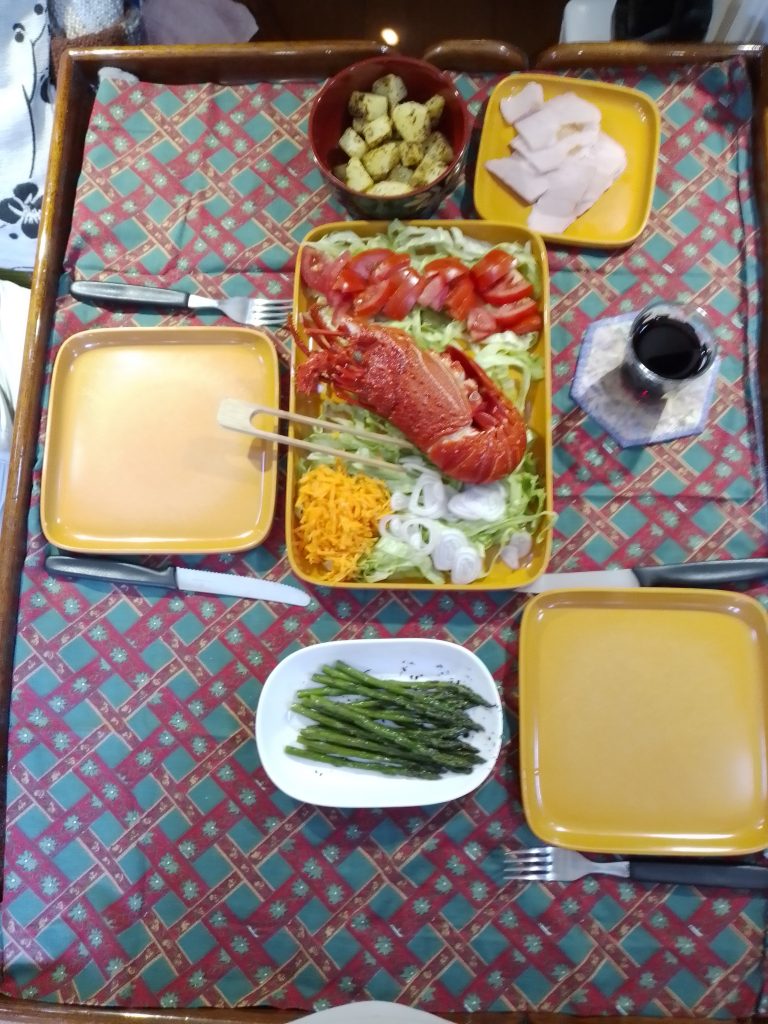
They certainly live well aboard Tui!
After 6 days of R & R in Triabunna we set off for Maria Island and the Denison Canal. The Denison Canal is a man-made canal located at Dunalley and shortens the sail from Maria Island to Hobart by 30nm from the trip around Tasman Island. We made the trip up to Hobart in 3 days. On arriving there, we were able to stay for a short time at the small Marine and Safety Tasmania marina in the centre of Hobart. We later moved to a berth at the Derwent Sailing Squadron marina, until it was time to move to our berth position for the 4 days of the festival.

Tui in Hobart for the Festival: ‘lending tone’.
The festival is held over 4 days starting on Friday and finishing in Monday. It is located on the waterfront at Hobart and covers a distance of 1.2 km along the waterfront. I’m not sure of the daily attendance but if past festivals are any guidance, it would be 50,000 per day. On our dock the visitors started arriving at 0630 hours and the last departed at 2130 hours.
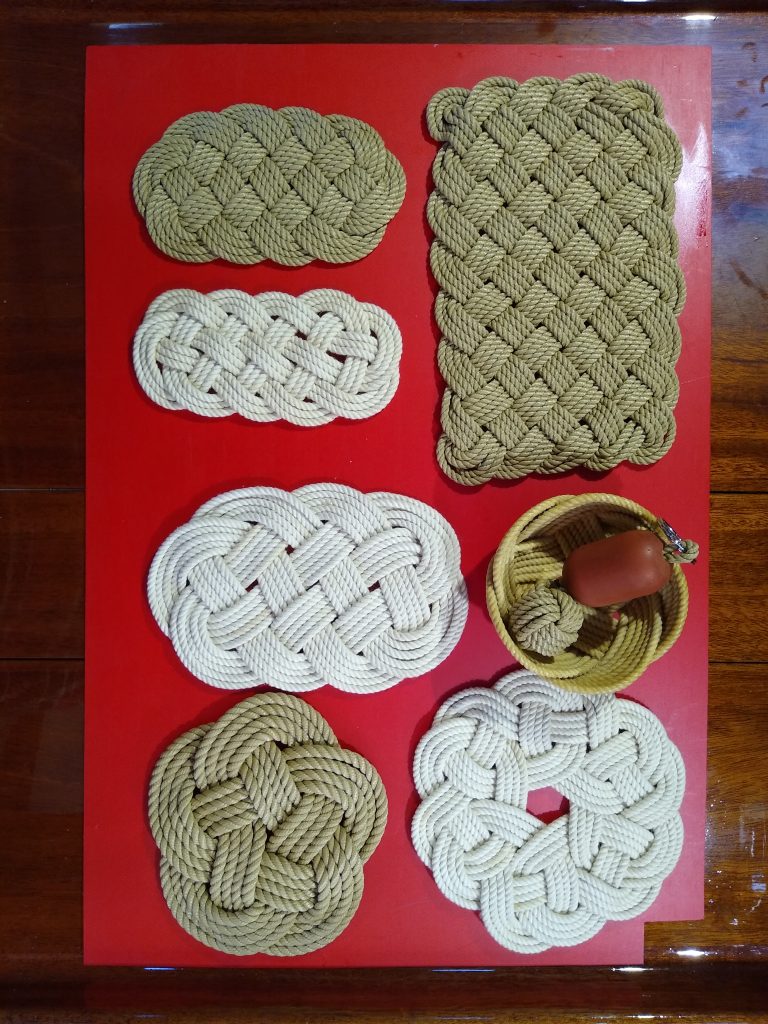
Thelma went each day to the shipwrights’ tent to give a demonstration of rope mat making. (Aren’t they wonderful!)
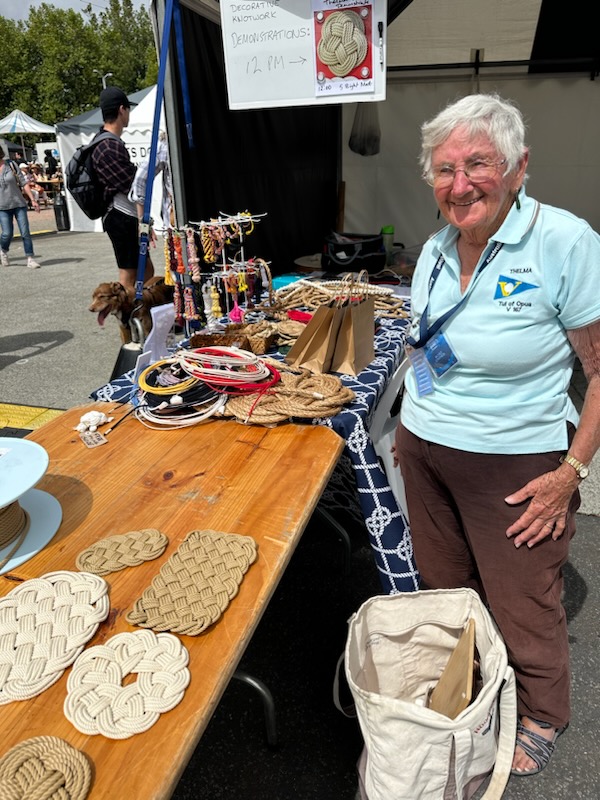
I was able to talk to many of the visitors who knew something of the Vertues, including one visitor who had worked at Laurent Giles & Partners in the UK. He told me that the firm had a Vertue and were encouraged to take her sailing on a Wednesday evening. Other visitors had built Vertues professionally during their working life. We stayed on board throughout the festival as the marina has very good facilities for our use. The festival hosts about 50 food outlets over the 4 days with every type of food available.
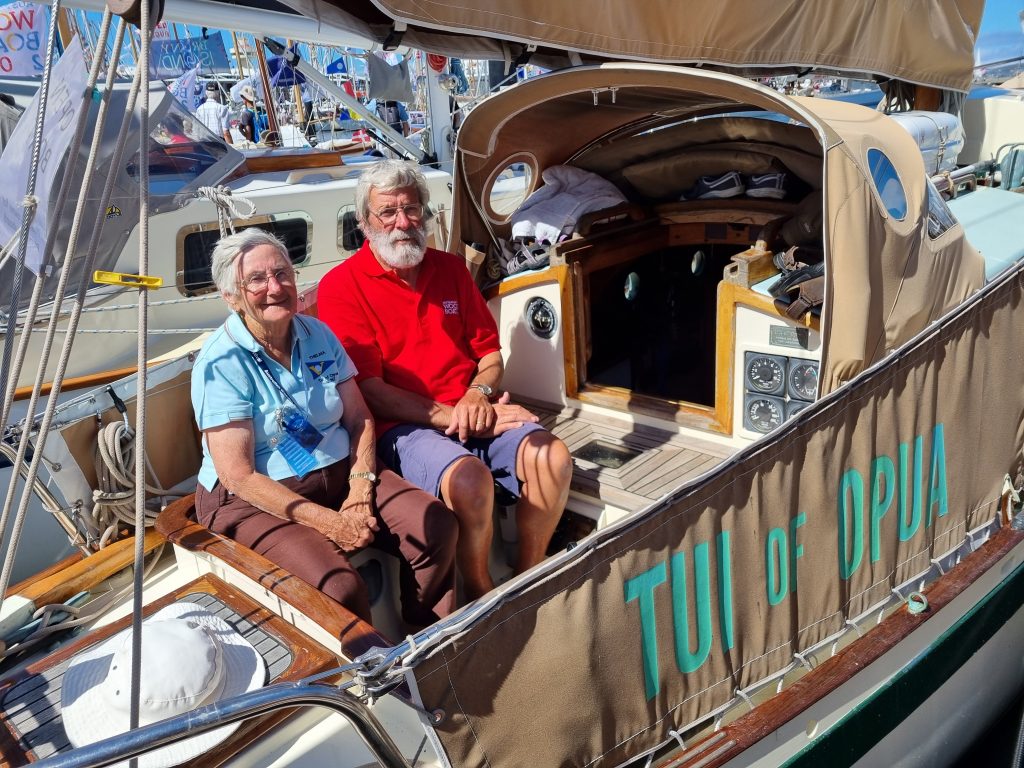
Bruce and Thelma Morley aboard their exquisite Vertue Tui of Opua. Photo taken by the Australian magazine Afloat.
After the 4 days of the festival, we sailed down the channel to Kettering where we will live aboard for the next 12 months so we can enjoy the excellent sailing in Tasmania.
I have tried to tell the story of our sailing trip to Tasmania and the Wooden Boat Festival. Thelma and I had a wonderful time and are so glad that we made the effort to sail down to Tasmania, having in our minds the last time we crossed Bass Straight heading south and a difficult crossing. We will stay in Tasmania for at least the next 12 months before deciding on our next trip.”
____________________________

This is probably Jilly (or Jillie?), a grp VII. The rig certainly ‘looks right’ on her, but I have no idea who owns her or where she is based. Can anyone help, please? I would guess that she is probably based somewhere on the East coast of the UK.
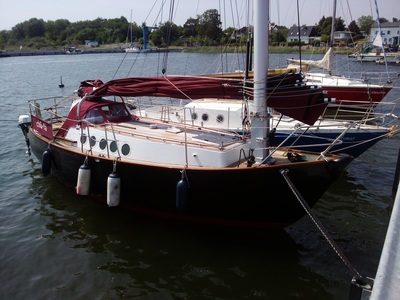
Here is Chu Fa, and having just heard from her owner, I’m taking the opportunity of reminding us all about this interesting sub-group of the class. Ute tells me that he is the third owner of Chu Fa and is thinking of selling her. Her original owner once told me that he was inspired by Shirley Carter’s Speedwell to rig her with a single, unstayed junk mast.
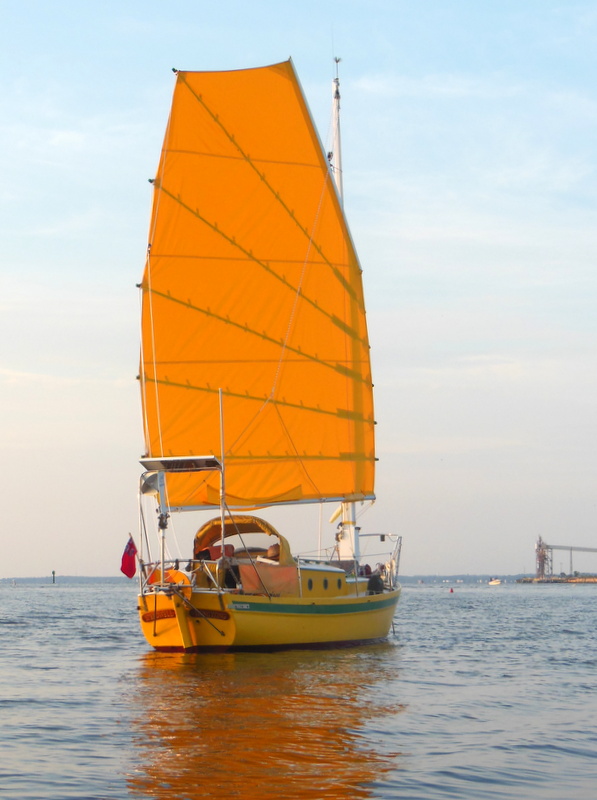
Here is Shirley Carter’s venerable Speedwell of Hong Kong.
For anyone not yet familier with Shirlz delightful blog about Speedwell’s continuing meanderings around the globe, please have a look at http://speedwelladventures.com/blog/. You’ll be in for a real treat!
________________
THE VERTUE DESIGN DYNASTY 3
Valfreya
In the autumn Newsletter we looked at the conception of Kalliste, as a ‘large Vertue’. However, at about the same time the Giles Partnership was approached by Captain P.C. Bullock who asked them to design an even larger version of the type. Bullock was one of a group of Royal Cruising Club members who admired the way Giles seemed to be able to create fine, weatherly, handsome cruising boats, that retained something of the ‘pilot cutter’ type, and which were also remarkably fast. Whereas Kalliste was 24’6″ on the waterline, Capt. Bullock’s new Valfreya was to be 28′.
Valfreya‘s rig was a slightly more traditional, and snugger, version of the double-spreader, higher aspect ratio rig of the post Monie Vertues, and Kalliste. This cutter rig, with bowsprit, gave more headsail options whilst the bermudan main with standing backstay to a bifurcated boomkin retained the secure, efficient driving force, that was becoming accepted by even the most traditionally-minded cruising men of the time.
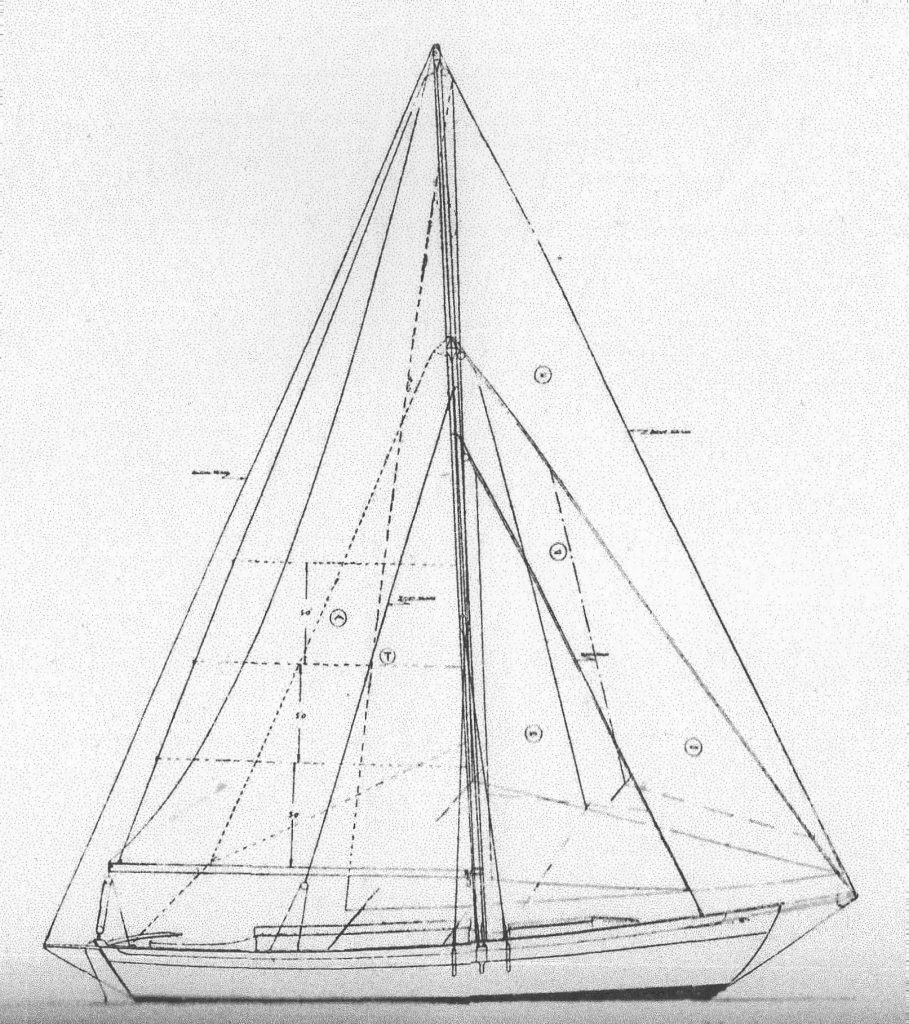
Valfreya’s bermudan cutter rig


Like Kalliste, Valfreya had sufficient length to incorporate a proper, seagoing sleeping cabin forward of the saloon, which was still far enough aft not to be too subject to the yacht’s motion when on the wind. This accommodation was reputed to have been built to Bullock’s sketches, although it does look to me as if these might well have been based on the earlier boat’s layout. Both boats have a quite remarkable degree of tumblehome aft, and the midship sections are similar, but there is more drag to Valfreya’s keel than any of her ‘sisters’ in this design dynasty.
Captain Bullock had heard such glowing reports of a Swedish boatyard near Karlskrona, that had just built a ‘kosterbat’ called Svenska for the RCC Vice Commodore , T.N. Dinwiddy, that he decided to have his own boat built there, too. Consequently, he used the opportunity of delivering the old converted pilot cutter, Dyarchy, to Mariehamn for her owner Roger Pinkney, to take a ‘cargo of gear’ for the new Valfreya on the way. Unfortunately the Truedsson boatbuilding family had not actually started the new boat when Dyarchy arrived with the gear, but were clearly charming and extremely friendly, and promised to “have her ready up to time”. I’m sure they did, for they were to be asked to build the most famous of the RCC boats of that era the very next year.
Valfreya returned to cruise the Baltic twice more before the War, and also won some offshore races. In the mid 1960’s she was fitted out to sail on an ambitious cruise to New Zealand and sailed as far as the Tuamotu’s, or ‘Dangerous Archipelago’ in 1966. Sadly, she became a total loss on the coral reef surrounding the beautiful tropical atol of Ahe, and her crew walked ashore, having lost everything.
By 1938 the teething troubles that had been experienced with the build of the second ‘Vertue’, Sally II, had been addressed by the partnership, and the drawings for a third boat, Monie, were drawn. These drawings became the template for the design until well into the 1940’s and were almost certainly used for all of the next half-dozen ‘Vertue’s. It wasn’t until 1946 that the Partners realised they had sufficient boats to give them a ‘class’ name, and that year they produced the design for Kishti, V12, complete with her doghouse. Perhaps this was also a response to some of the other pocket cruising yachts that were becoming popular: such as Harrison Butler’s ‘Zyklon’ class, and Whisstock’s Boatyard’s ‘Deben 4-Tonner’ designed by William Maxwell Blake. But I digress, for in addition to Valfreya the Partnership were also commissioned to build a third, larger version, of the type for racing and cruising in home waters.
Fairlight
The design of Fairlight is slightly closer to the ‘pure Vertue’ hull shape than Valfreya and bears an uncanny resemblance to the Andrillot, as she is rigged these days: although she is of course much larger.
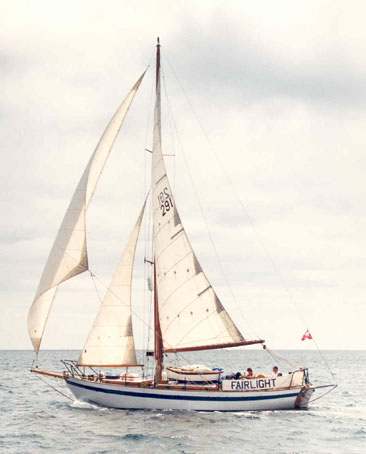
Fairlight has a similar deckhouse layout to Kalliste but at almost 39′ on deck she has plenty of space for a large cockpit and the dinghy stows easily on the main coach roof. This is carefully designed to provide excellent all-round visibility for the ship’s dog, who likes to keep an eye on what’s going on!


Here is Fairlight tramping along effortlessly past the Dodman whilst racing from Fowey to Falmouth, with the rest of the fleet strung out astern!

Fairlight‘s sailplan, which also shows her exquisite sheer.
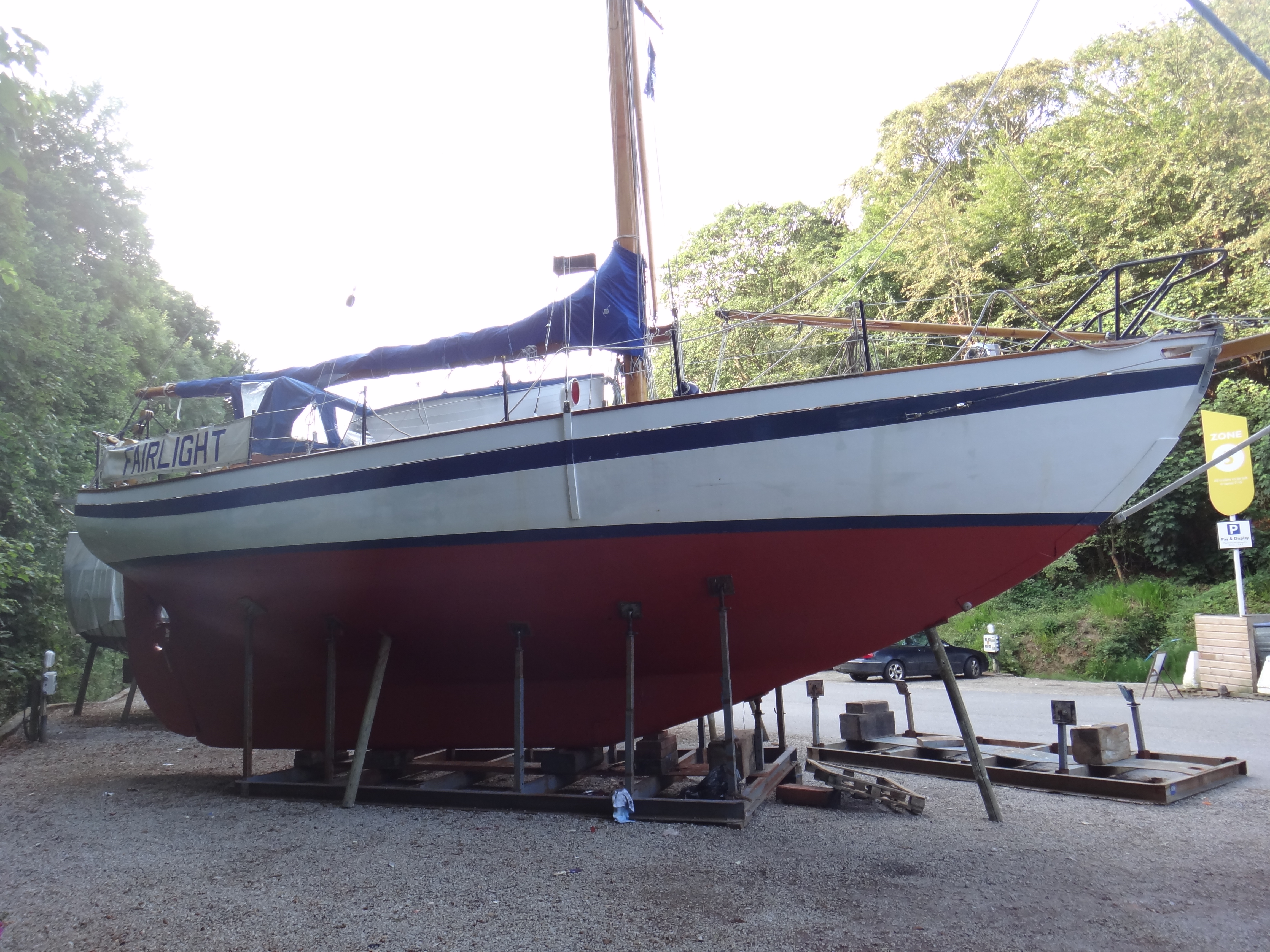
Unusually, Fairlight was built by the North Devon yard of J. Hinks & Son. This West Country yard had an enviable reputation for building working boats and yachts, and is of course on the south coast of the Bristol Channel, renowned for it’s pilot cutters. Her dimensions, of 39’x32’x10’8″x6′ draft, represented the largest version of the Vertue type in 1938. Like Valfreya she turned out to be surprisingly fast, winning the Cock of the Bristol Channel Race, twice before the war, and she has been a well-known competitor at Falmouth Week for many years. With Kalliste now based in the Pacific Northwest, and Valfreya sadly lost, Fairlight is the last remaining, bermudan cutter-rigged version of the ‘Large Vertues’ left in this country.
_______________
Here at VertueYachts.com we want to thank all those owners and others who have made this edition of our regular Newsletter possible. We are planning to continue it’s publication about every quarter, and as you can see from Bruce and Thelma’s delightful contribution, we are hoping to publish many more contributions on ‘Vertually’ anything in the future. Think of it as a mouthpiece for the worldwide Vertue community.
Fair winds!
Roger
______________________________
